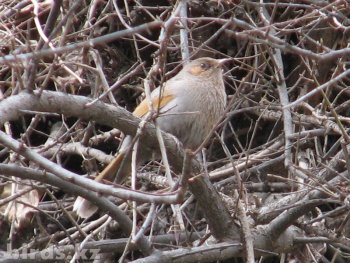Alternative name: Himalayan Laughingthrush

Photo by Alok Tewari
Hill Station Nainital, Alt. 6800 ft., Uttarakhand Himalayas, India, November-2012
- Trochalopteron lineatum
Identification
18 - 20cm (7-7¾ in). A small laughingthrush.
- Greyish to brownish-grey plumage
- Narrow shaft-streaks over most of plumage except vent and rump
- Rufescent ear-coverts, wings and tail edgings
- Broad pale grey tail-tips beyond black subterminal bands
Subspecies vary in colour (browner or greyer).
Distribution
Found in the Himalayas and adjacent mountain chains from Uzbekistan and Tajikistan to Afghanistan, Pakistan, India, Nepal and adjacent southern Tibet.
Common in most of its range.
Taxonomy
Bhutan Laughingthrush has been considered a subspecies of this species in the past.
This species is sometimes placed in the genus Strophocincla or formerly in Garrulax.
Subspecies
Four[1] to five subspecies recognized:
- T. l. schachdarensis in Uzbekistan and southeast Tajikistan (merged with bilkevitchi by Clements)
- T. l. bilkevitchi in southwest Tajikistan and adjacent southeast Uzbekistan to Afghanistan and western Pakistan
- T. l. gilgit in northern Pakistan and adjacent eastern Afghanistan
- T. l. lineatum in northeast Pakistan and northern India (Uttaranchal Pradesh)
- T. l. setafer in Nepal, Sikkim, northern West Bengal (India) and adjacent southern Tibet
Habitat
Bushes and scrub on hillsides and open forest, forest edge, around human habitation, field borders, gardens. Found from 1400m to 3900m.
Behaviour
Diet
Feeds on insects, berries, fruits and seeds. Will occasionally also take breadcrumbs.
Very conspicuous and a garden bird in many towns and villages, especially in the western Himalaya. Forages on the ground in pairs or small groups of 3 to 6 birds.
Breeding
Breeding season from March to October. The nest is a loose, untidy cup made of coarse dry grasses, fine plant stems, dead leaves, plant bark, creepers, dry twigs, fern and moss. It's placed in a thick bush or low in a tree, sometimes also in grass or even in honeysuckle on house verandah. Lays 2 - 4 eggs. The nest is often parasitized by Jacobin Cuckoo, Large Hawk-Cuckoo and Indian Cuckoo.
Movements
Resident species with some altitudinal movements in harsh winters.
Vocalisation
Recording by Alok Tewari
Dwarahat, Alt. 5200 ft above MSL, Uttarakhand Himalayas, India, April-2015
Song and call given by one individual at the beginning of the nesting season.
References
- Clements, J. F., T. S. Schulenberg, M. J. Iliff, D. Roberson, T. A. Fredericks, B. L. Sullivan, and C. L. Wood. 2017. The eBird/Clements checklist of birds of the world: v2017, with updates to August 2017. Downloaded from http://www.birds.cornell.edu/clementschecklist/download/
- Avibase
- Del Hoyo, J, A Elliott, and D Christie, eds. 2007. Handbook of the Birds of the World. Volume 12: Picathartes to Tits and Chickadees. Barcelona: Lynx Edicions. ISBN 978-8496553422
- Rasmussen, PC and JC Anderton. 2005. Birds of South Asia: The Ripley Guide. Barcelona: Lynx Edicions. ISBN 978-8487334672
Recommended Citation
- BirdForum Opus contributors. (2024) Streaked Laughingthrush. In: BirdForum, the forum for wild birds and birding. Retrieved 14 May 2024 from https://www.birdforum.net/opus/Streaked_Laughingthrush
External Links
GSearch checked for 2020 platform.1




